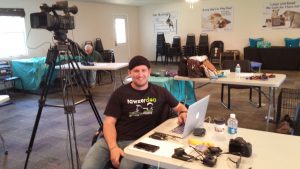Report from PPG’s Four-Day Pet Care Technician Certification Program Workshop (Part Five of Eight)

Louise Stapleton-Frappell listens to Rebekah King’s presentation on anatomy and physiology
This is part of a series of blogs in which we will share a few of the highlights from day two of PPG’s recent workshop and my presentation on Pet Care Tools, Equipment and Toys – a study of pet care tools, equipment, supplies and toys that are available in today’s marketplace. The presentation covered such topics as learning how to identify appropriate equipment and understanding how to safely and practically use this equipment including desensitization protocols. Everyone also learnt some fun games to play with their canine clients!
The presentation contained an overview of many of the different pet toys available – including but not limited to interactive puzzles, kongs, frisbees, giggle balls, jolly balls, tennis balls, egg cartons and even muffin tins! Toys are an important part of the pet care tool kit. They are great for keeping dogs busy, for motivating and rewarding. They provide both physical and mental stimulation: “There is no easier way to exercise a dog than throwing a toy or tennis ball but an interactive puzzle toy can be equally amazing tool. Infirm, elderly or injured dogs can be kept mentally stimulated when physical exercise is limited. A simple nylabone can make for a very happy dog and a happy owner.”
We looked at clickers, gates, crates, kennels, cleaning supplies and odor management. I discussed the many benefits of using a target stick, especially for moving or positioning a pet but also for use as a game and as a fantastic way to strengthen the bond with a pet in the technician’s care. Target sticks can be a great tool for pet owners and not just for professionals. Everyone learnt the mechanics of using a target stick and how to safely and effectively introduce the target stick to a pet while creating a positive conditioned emotional response. All the skills learnt were put to good use in the practical exercises when the students moved a dog onto a bed using a target stick and then used the target stick to move a dog into a crate.
When any equipment is introduced a pet will have an emotional response – this could be negative or positive. I discussed the importance of creating a positive conditioned emotional response to any new tools or toys the pet is introduced to, stressing the need to always endeavor to create this positive association by using desensitization protocols. Building a positive association to equipment – muzzle, gentle leader, harness, collar, leash is crucial to a pet’s overall mental and physical well-being! Taking the time to create a +CER to muzzles and other equipment is essential. You may think you will never need to use a muzzle on a particular pet but you never know when a muzzle might be needed in an emergency situation. How much better if the pet already has a positive response to muzzles and is happy to wear one? In what could already be a very stressful situation, the last thing you want to do is add to the stress by suddently introducing a piece of equipment that terrifies the pet! In an emergency situation with an unknown dog you can only do the best you can do at that moment in time but you have the opportunity beforehand with the pets in your care. Association of equipment can be a fun game to play! All the students had lots of fun creating positive associations to collars, leashes, muzzles, head halters and harnesses, as well as learning how to safely fit them!
It was soon time to play (carry out a practical exercise)! Everyone had lots of fun learning how to play tug safely – a game I highly recommended. Here are a few of my tips for playing tug safely:

Playing tug is fun for both dogs and their people Photo © CanStock Photo
- The game starts – the tug comes ‘alive’.
- ‘Tease’ but do not thrust the tug toy at the dog.
- The game ends or takes a short break – the tug goes ‘quiet’, close to your body.
- The reward for dropping the tug? The game starts again.
- Practise basic manners and cues: “Take it, drop it, sit, wait… “
- Remember to put the tug away when the game is finished.
Here are some ideas I shared for troubleshooting when playing tug with a dog: What should you do if a dog’s teeth touch human skin? The answer is very simple – the game stops. What about a dog who is overly animated? Slow the game down. What can be done to stop a dog jumping up to grab the tug toy? Lower the tug. Is there any way to get a dog who appears disinterested in the game more eager to interact? Yes, pair the tug with a primary reinforcer!

A PPG Certified Pet Care Technician DVD will soon be available from Tawzer Dog
In part six, we will take a look at day three and part two of Niki Tudge’s presentation, What is Force-Free Ethical Pet Care? Caring for Pets, Protocols & Procedures

If you would like to know more about pet care, why not sign up for The Pet Professional Guild’s Virtual Pet Care Summit taking place on Thursday, August 11 and Friday, August 12, 2016 ? There will be more than 25 hours of educational webinars across a variety of topics geared towards the pet care professional! More information and online registration here.
